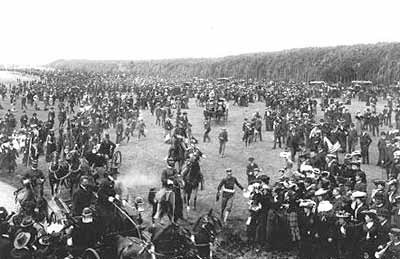
Anthony Powell Collection The 9th Cavalry Regiment consisted of three squadrons, each of which was assigned to a different post on the West Coast. The 3rd Squadron, consisting of four troops or companies, were garrisoned at the Presidio of San Francisco. Commanded by Major Joseph Garrard, the 3rd Squadron arrived in San Francisco in October 1902. The commander of "I" Troop was Captain Charles Young, the only African American troop commander in the regular army. A man of many talents, Young was the only Black graduate of West Point still serving in the army. Garrison life at the Presidio was uneventful for Captain Young and his troops. Most soldiers occupied their time with the usual mundane military activities of work details and guard mount. Off duty enlisted men who stayed on post participated in various sports. Each company fielded its own team, with baseball being a particularly popular sport in the army at the time. The soldiers also socialized with San Francisco's small but closely knit African American community. 
Life changed for the 3rd Squadron in April and May of 1903, when it was assigned two special missions. On April 23rd the squadron was divided, and Troops K and L were dispatched to Wawona, California, at the southern boundary of Yosemite National Park. Their mission was "to establish a camp with the purpose of protecting the Park from injury and depredations." These black troops spent the entire season patrolling and maintaining the national park. (28) Captain Young and the men of I and M troops remained at the Presidio for one last duty before being dispatched to patrol Sequoia National Park. Their duty was to serve as special escort to the President of the United States, Theodore Roosevelt, on his West Coast tour of California. The President visited San Francisco on May 12th through 14th. Thousands of people turned out to greet the Chief Executive. Accompanying the President through the streets of San Francisco were Buffalo Soldiers on horseback flanking several carriages of honored guests. (29) Captain Young was attired in his dress blues; the soldiers were resplendent wearing their neat but simple blue uniforms with a pill box cap, white canvas leggings and gloves. The troops provided not only an escort and security for the distinguished guest, but also served as "Guard of Honor." The San Francisco Call lauded Troops I and M as two "crack military organizations that had the honor of forming Roosevelt's escort." (30) For many of these men, the escort duty had been a reunion of sorts, having last seen "Colonel" Roosevelt on the crest of San Juan Hill in 1898. Although Roosevelt had praised the Black soldiers shortly after the battle, he had since incensed them by making disparaging remarks about their worth as professional soldiers in Scribner's magazine. The use of the 9th U.S. Cavalry to provide his escort may have been seen by some as an apology of sorts. Having Captain Young as I Troop commander certainly gave the President a first hand look at a Black man who was a competent commander and troop leader. 
Theodore Roosevelt had a complex relationship with his African American constituents. In 1904 Roosevelt created a sense of future equality for Blacks when he invited educator Booker T. Washington to dine at the White House. This was the first time an African American was an honored dinner guest of a President of the United States. Then, in 1906 a small group of soldiers from the 25th Infantry Regiment shot up the town of Brownsville, Texas, killing one civilian and wounding a police officer. Unable to identify the guilty men, the army, backed by President Roosevelt, summarily dismissed without honor 167 Black infantrymen, not one of whom had been found guilty of any wrongdoing. These soldiers included several senior non-commissioned officers who had made the army their career, and the privates and corporals of three companies. By the stroke of a pen worthy of any Jim Crow politician, Theodore Roosevelt destroyed any previous good will his administration had generated among African Americans. < Return to Buffalo Soldiers Home The Philippine War – A Conflict of Conscience |
Last updated: February 9, 2022
